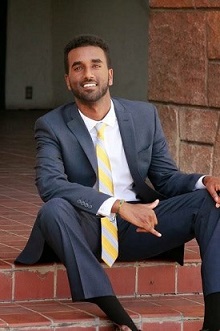This month’s professional spotlight features Senai Andikiel. Senai is a program manager for the Department of Defense’s Legacy Resource Management Program. Read this month’s spotlight to learn more about Senai and his work.
Could you briefly explain some of your responsibilities in your career role?
I am a program manager for the Department of Defense’s Legacy Resource Management Program. In this role, I’m virtually the liaison between the military services (Army, Navy, Marine Corps, Air Force) and the scientific researchers at military installations conducting several environmentally related projects. These projects vary anywhere from proper land management, biodiversity, and a list of other things I’m not allowed to go into ha-ha. In addition to my role as program manager, I am a SME (subject matter expert) in all thing’s sustainability. Various sustainability-related projects done across the DoD are usually ran by me for scientific soundness and validity, and occasionally I help lead some of these projects. Most people are shocked by the DoD’s interest in the environment but in fact they are often leaders in progressive and tangible environmental efforts.
What inspired your career path and interest in the environment?
As a kid I always wanted to be a superhero, saving the world and helping people was always something I wanted to do. In addition to wanting to be a superhero, my identity as an Eritrean was so strong at a young age that I knew I needed to do something to contribute to our newly freed homeland. Growing up and learning about the world’s environmental issues and how real of a threat it was only made me realize that I could actively save the world and help our people in a real way. I believe that both development and environmental stewardship have a symbiotic relationship in which impoverished and developing nations could actively improve their respective condition without destroying the very land they love and without outside influence, dependent wholly on the power of the people and the environment.
Can you talk some about what environmental sustainability is and why it is important?
Sustainability is such a broad and all-encompassing subject so much so that is difficult to define. It is quite often simply defined by the 3 “E” s, Environment, Economics, and Equity. We are faced with environmental, economic and social issues which are products of a deliberate public policy and they have left a history of disparity with which we must deal in order to be sustainable. This may be the first time in human history that we leave our children a world that’s in a worse place than what was given to generations prior. Understanding the very real existential threat of climate change is not only important but necessary.
What is a major environmental issue in your opinion that more people need to be concerned about?
I don’t think there is one particular environmental issue that needs to be focused on per se but rather the discussion in and of itself, particularly in communities of color and the developing world. Developing countries and communities of color, unfortunately, bear the brunt of the damage more from the economic impacts of climate change, as well as being the least able to adapt to new climatic conditions. Reducing vulnerability and helping the poorest and most marginalized communities to adapt have been almost absent from the climate change agenda. Issues such as droughts, floods, lack of agricultural production, harm to fisheries and marine life, water resource availability, industry and human health factors are all expected to increase the disparity in wealth between the developed and developing world and redistributive impacts are one of the major reasons for concern about the climate change phenomena. Every environmental challenge is local in nature and every community has a culture. The capacity for building community engagement must recognize the likelihood that communities will have distinctive views and demand incorporation of those distinctive elements into any plan for sustainability. Sustainability will require us to confront disparities that exist because of our history and deliberate public policy decisions that were made to sacrifice certain groups and communities.
What was your approach to following your career path?
That’s a tough question. I think while in school I had my hands in every proverbial pot and that helped narrow what I wanted to focus on in respect to my career path. But I’m a big believer in dynamic and positive flux meaning that there are many avenues to approach the issues I want to tackle but getting a solid grasp of the general path I wanted to take helped me zero in on what I wanted to do.
Is there a philosophy that drives your career?
The Marathon Continues…
What do you consider to be your greatest professional accomplishment?
I don’t think I have a great professional accomplishment just yet but rather one of the most important things I’ve been doing is spreading the message of environmental stewardship and sustainability in a relatable way to people who look like me. Having candid or formal conversations in our communities about this major threat to our livelihoods is something I aspire to do in every respective community I live or will live in.
What tips or advice would you offer anyone looking to follow a similar career path?
The best advice I’d give to anyone wanting to pursue work in the environmental space is don’t be discouraged and keep fighting the good fight. I know that the future looks bleak and that climate scientists don’t help by painting a morbid apocalyptic future if we don’t change, but understand there is always hope. If there is anything that climate change has taught us, it is that our future is in our hands and it is up to us to choose what that looks like. I know exactly what I’m fighting for.
Outside of all your hard work, what do you do for fun? Hobbies?
Outside of reading about the imminent end of the world because of climate change, I’m a big comic nerd and collector, I also love working with children and volunteer my time at local community centers and youth facilities.


Wow my brother always proud off you and love you so much
“Having candid or formal conversations in our communities about this major threat to our livelihoods is something I aspire to do in every respective community I live or will live in.”
Thank you for giving back to communities of color, and making sure there is representation and a voice when it comes to environmental concerns.
It warms to see a compatriot in such a key position.. I wish you all the best and keep soaring up!